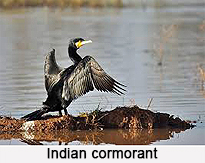 Indian Cormorant, also known as Indian Shag is a member of the Phalacrocoracidaet family. Its scientific name is "Phalacrocorax Fuscicollis". It is a gregarious species that can easily be distinguished from the similar sized Little Cormorant by its blue eye, small head with a sloping forehead and a long and narrow bill, ending in a hooked tip. Indian Cormorant chiefly consumes fishes. The bird indulges in pursuit-diving to grab fish. Although it is a resident bird, it makes some seasonal movements. This bird has been labeled as "least concern", according to the IUCN (International Union for Conservation of Nature) red list assessment.
Indian Cormorant, also known as Indian Shag is a member of the Phalacrocoracidaet family. Its scientific name is "Phalacrocorax Fuscicollis". It is a gregarious species that can easily be distinguished from the similar sized Little Cormorant by its blue eye, small head with a sloping forehead and a long and narrow bill, ending in a hooked tip. Indian Cormorant chiefly consumes fishes. The bird indulges in pursuit-diving to grab fish. Although it is a resident bird, it makes some seasonal movements. This bird has been labeled as "least concern", according to the IUCN (International Union for Conservation of Nature) red list assessment.
Structure of Indian Cormorant
Indian Cormorant is a medium-sized bronze brown bird. It has a slightly peaked head and longish tail and lacks a crest. During the breeding season, the bird is mostly black in color and has white neck plumes and a whitish throat. During the non-breeding season, the bird has bare yellow facial skin. Breeding birds have a short and white ear tuft. In some plumages, white throat is evident, but the white color is restricted below the gape, unlike in the much larger, Great Cormorant. Sexes are similar, but non-breeding adults and juveniles are browner.
Distribution of Indian Cormorant
Indian Cormorant is found mainly along the inland waters of the Indian subcontinent and is widespread in the country. More specifically, it occurs in estuaries and mangroves, but not in the open coast. It extends north-east to Assam and eastward to Thailand, Burma and Cambodia. They have also been traced in countries like Pakistan, Sri Lanka, Bangladesh, Myanmar and Vietnam.
Breeding of Indian Cormorant
Indian Cormorant breeds locally in mixed species breeding colonies. Its breeding season ranges from July to February, but depends on rainfall and water conditions. In northern India, the bird breeds from July to February and in Sri Lanka, it breeds between November and February. The nest is a platform of twigs placed in the forks of partially submerged trees or those growing on islands. Nests are placed in close proximity to those of other Indian cormorants or storks or water birds in dense colonies, often with several tiers of nests. The usual clutch is of three to five eggs, which are bluish green, with chalky surfaces.











